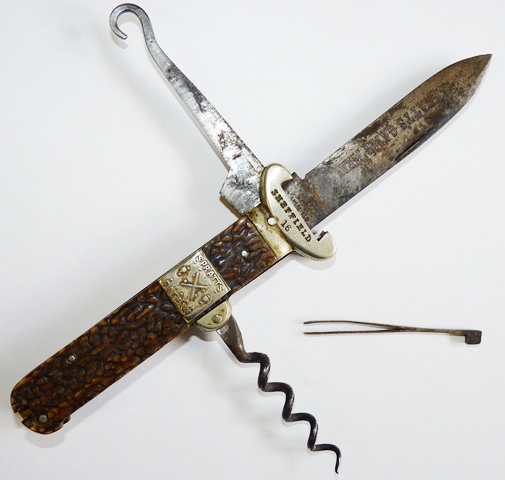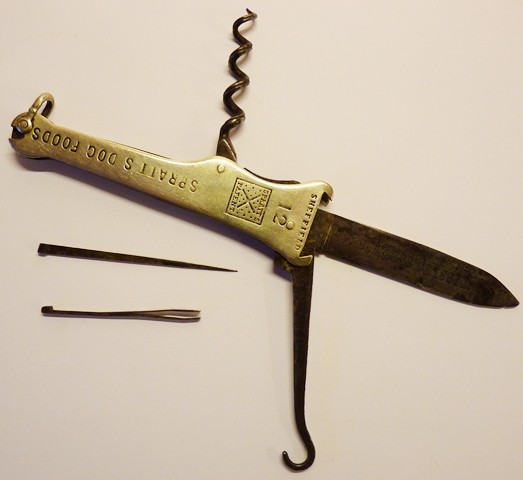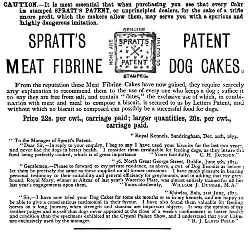Spratt's Multi-Tools - by Graeme Nott.
Spratt's were the first manufacturer of dog biscuits on an industrial scale, the company was founded around 1860 by James Spratt, an American electrician and lightning rod salesman from Cincinnati, Ohio. Spratt established the company in Holborn, London, selling his dog biscuits to the shooting fraternity. The company also began operating in the USA during the 1870’s; it was in 1880 after the death of James Spratt that the company went public and underwent a name change to Spratt’s Patent Limited.
Charles Cruft (founder of the famous dog shows) was one of Spratt’s first employees and key in the development of the company and the brand. As the company became increasingly successful others tried to copy its products. Spratt sought to protect his brand by developing a trademark, using the ‘X’ that Cruft used in the company ledgers to distinguish between trade and private clients.
Spratt’s began to advertise heavily from the 1880’s and used snob value to appeal to the high end market of dog owners and the shooting fraternity. The shooting multi-tools which included a corkscrew were an advertising item produced by Joseph Westby of Sheffield (marked on the blades) probably from the late 1880’s; these tools would have certainly appealed to the upper classes of the late Victorian period and would have been a good advertising medium for Spratt’s products.
Joseph Westby was the son of William Westby who worked as a manager and later partner at Brookes and Crookes of Sheffield (corkscrew maker and cutler). Joseph started his working life as an apprentice at the Brookes and Crookes factory. Joseph had struck out on his own by the mid 1870’s listed as a knife maker between 1876 and 1888; later he also made scissors, razors and was one of the first producers of stainless steel cutlery. The products all seem to have been high quality and often using expensive materials such as ivory and silver (silver marks for Westby were registered in 1893 and 1894) a number of examples of razors and knives have survived from this period. The company later became Joseph Westby & Co Ltd, Joseph himself died in 1929 but the company continued to trade until 1965.
Joseph Westby is also recorded as registering a patent for a pocket tool in 1892 along with Charles Swift Levick who became a steel manufacturer. The specific patent refers to a button hook with a shaped end, as it pivots within a pocket tool/shooting knife it creates a graduating cartridge extractor. This tool seems to have been manufactured by Brookes and Crookes as it is recorded as carrying their trademark bell, (see British Corkscrew Patents From 1795, Fletcher Wallis p.215). The overall design of this pocket tool is not dissimilar to those produced for Spratt. It does seem a little odd that Brookes and Crookes are recorded as the manufacturer for the tool as Joseph had already started his own business by 1892; it maybe that a relationship existed between Westby’s company and Brookes and Crookes, possibly trading parts for different tools, assembly of components etc. or perhaps Swift Levick worked for Brookes and Crookes.
The multi-tools are no exception in terms of their quality, being well made, using good quality grooved worms on the corkscrews and expensive etched or engraved blades for the advertising of Spratts’s products. One wonders if the inclusion of a corkscrew was the idea of Spratt being that his business was located in the Holborn, a name synonymous with corkscrews or whether the idea came from Westby influenced by his time at Brookes and Crookes. Alternatively the tools may have been a generic item produced by Westby as a high end advertising medium, there may be others out there advertising other products.
SPRATT’S Factory in London, Tower Hamlets still stands and can also be seen from the Docklands Light Railway (DLR).




_-_geograph_org_uk_-_935037.jpg)
